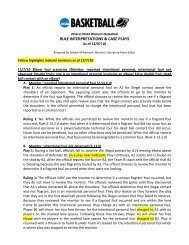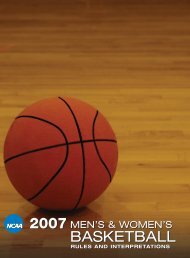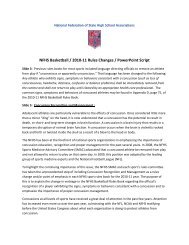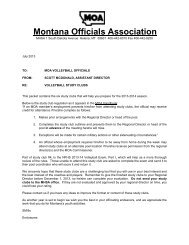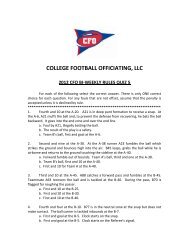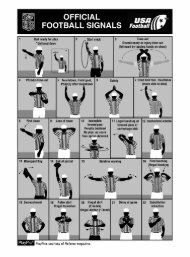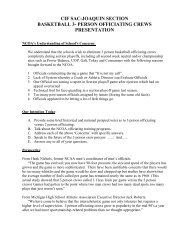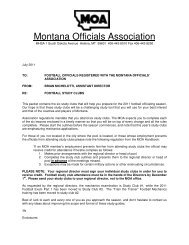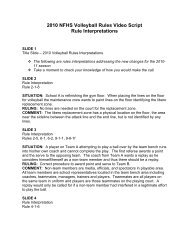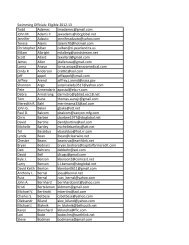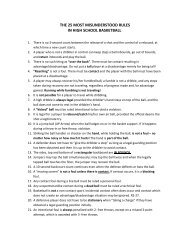MONTANA OFFICIALS ASSOCIATION - MOA - ArbiterSports
MONTANA OFFICIALS ASSOCIATION - MOA - ArbiterSports
MONTANA OFFICIALS ASSOCIATION - MOA - ArbiterSports
You also want an ePaper? Increase the reach of your titles
YUMPU automatically turns print PDFs into web optimized ePapers that Google loves.
BACKCOURT VIOLATIONS<br />
A player shall not be the first to touch a ball after it has been in that team’s control in the<br />
frontcourt, if they or their teammate last touched or was touched by the ball in the frontcourt<br />
before it went into the backcourt. While in team control in a player’s backcourt, that player shall<br />
not cause the ball to go from backcourt to frontcourt and return to the backcourt, without the ball<br />
touching a player in the frontcourt, and be the first to touch the ball in the backcourt. A player from<br />
the team not in control (defensive player or during a jump ball or throw-in) may legally jump from<br />
their frontcourt, secure control of the ball with both feet off of the floor and return to the floor with<br />
one or both feet in the backcourt. The player may make a normal landing and it makes no<br />
difference whether the first foot that returns to the floor is in the frontcourt or backcourt. The<br />
frontcourt status of a player is determined differently depending on whether the player is dribbling<br />
the ball from the backcourt to the frontcourt, or in possession of the ball or receiving a pass from<br />
the backcourt to the frontcourt.<br />
DRIBBLE VIOLATIONS<br />
There is no limit to the height of a dribble. The player may dribble the ball over their heads, as<br />
long as they do not come in contact with the ball below the equator of the ball.<br />
3-SECOND VIOLATIONS<br />
Allowance shall be made for a player who, having been in the restricted area for less than three<br />
seconds, dribbles in or moves immediately to try for goal. The count ends each time a shot is<br />
taken, and a new count begins each time the offensive team gains control. There is no threesecond<br />
count during rebounding situations.<br />
!V.<br />
Please take time as a group to review and discuss the Three Person Mechanics Guidelines<br />
below:<br />
BASIC RESPONSIBILITIES OF THE LEAD<br />
1. STAY IN YOUR PRIMARY<br />
Be square to baseline and facing your primary<br />
2. FIND A REASON TO ROTATE (WE WANT MORE ROTATIONS, NOT FEWER)<br />
L does not rotate enough<br />
If ball rotates over and post players rotate over and L does not rotate, there is too much<br />
for C to watch<br />
Having two officials on strong side increases chances of off-ball fouls being called,<br />
especially rough play fouls<br />
3. WORK THE BASELINE<br />
Start wide and close down as ball comes to middle of court<br />
Never officiate in the paint; only use during rotations<br />
Stay back 1-2 feet from baseline if it gives you a better angle (angles should dictate your<br />
positioning--should be 90 degrees between players, not straightlined)<br />
4. CLOSE DOWN AND PREPARE TO ROTATE<br />
Must close down before rotating<br />
5. USE OF DROP STEP<br />
If you are too late in rotating and there is a drive to the basket from the other side of lane,<br />
L should drop off the baseline (from the closed-down position) to get a better angle<br />
6. STAY AWAY FROM CALLING GOAL TENDING AND BASKET INTERFERENCE<br />
7. THREE POINT SIGNALS<br />
Only time you signal is on a fast break and leave hand up until T picks it up; don’t ever<br />
signal it is good




